Fix: Windows couldn’t automatically bind the IP protocol stack to the network adapter
Several users report getting the “Windows couldn’t automatically bind the IP protocol stack to the network adapter” error after they attempt to fix their wireless connection by running the Windows troubleshooter. Most affected users report that the issue started occurring after a botched Windows update or after they uninstalled a VPN software.
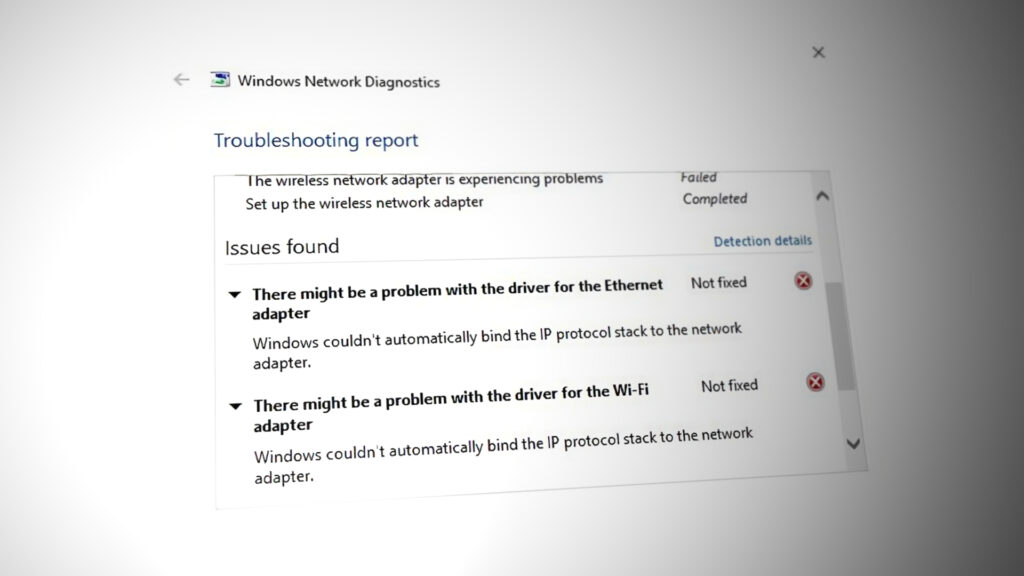
What is causing the Windows couldn’t automatically bind the IP protocol stack error
If you pay attention to the details, the error message is slightly pointing you to the source of the problem. We investigated this particular issue by looking at various user reports and the fixes that they used to resolve the problem. From what we gathered, there are several culprits that are often reported as being responsible for the apparition of this issue:
- Windows is unable to fetch the IP address using DHCP – When certain scenarios are met, Windows might have trouble fetching the IP address using Dynamic Host Configuration Protocol (due to a bad driver or some network tools that are conflicting).
- Virtual Private Network (VPN) client is interfering with the connection – This is one of the most common reasons why this particular error occurs. This scenario is frequently encountered when the user tries to delete the VPN client without following the official channels.
- Unsupported VPN software is installed during the upgrade – If you’ve recently made the upgrade to Windows 10, a Virtual Private Network software like Cisco VPN might have left behind some remnant files that are interfering with your wireless connection.
- WLan AutoConfig service is disabled – Certain applications or a bad Windows update might stop this service from being started at every system startup.
If you’re struggling to resolve this particular issue, this article will help you to troubleshoot the issue. Below you have a collection of fixes that other users in a similar situation have used to get the issue resolved.
For the best results, follow the methods below in the order that they are presented until you find a fix that is effective in resolving the issue in your particular scenario.
Method 1: Reverting to the default Network Adapter Properties settings
Let’s start simple – by making sure there aren’t any other network items that are interfering with the connection (other than the standard ones). It’s likely that you see this issue occurring because a 3rd party network client (VPN, Virtual Machine Networking driver, or something else) is causing your wireless connection to malfunction.
You can typically resolve any type of interference of this kind by ensuring that the Wi-Fi connection is only using the required items that it needs. Here’s a quick guide on how to do so:
- Press Windows key + R to open up a Run dialog box. Then, type “ncpa.cpl” and press Enter to open the Network Connections tab.

Run dialog: ncpa.cpl - Inside the Network Connections tab, right-click on the Wi-Fi network adapter that is refusing to work and select Properties.
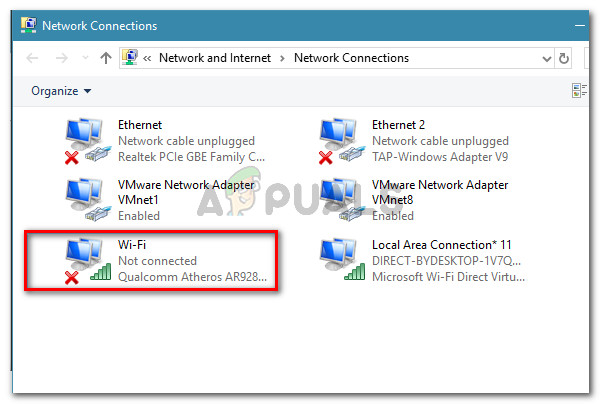
Right-click on your Wi-Fi network and choose Properties - In the Wi-Fi Properties screen, make sure that you are inside the Networking tab. Then, proceed to disable the checkbox associated with every entry that is not mentioned below and click Ok.Note: But before you do so, take the time to take a screenshot with your current configuration so you’ll know which settings to revert to in case this method is not successful.File and Printer Sharing for Microsoft Networks
QoS packet scheduler
Link-Layer Topology Discovery Responder
Internet Protocol Version 4 (TCP/IPv4)
Link-Layer Topology Discovery Mapper I/O driver
Internet Protocol Version 6 (TCP/IPv6)
Microsoft LLDP Protocol Driver
Client for Microsoft Networks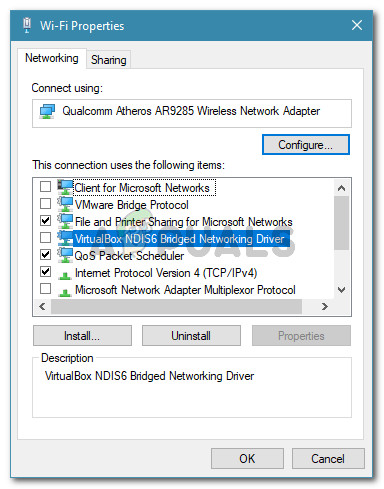
Ensuring that the connection doesn’t use 3rd party items - Connect your computer to the home (or work) network again and see if the error is now resolved.
If you’re still encountering the “Windows couldn’t automatically bind the IP protocol stack to the network adapter” error, move down to the next method below.
Method 2: Using Registry Editor to add a DhcpConnEnableBcastFlagToggle value
There’s another popular fix that seems to have helped a lot of users to resolve the “Windows couldn’t automatically bind the IP protocol stack to the network adapter” error.
This method involves using Registry Editor to navigate to the NetworkCards key and fetching the value data of the adapter that is displaying the error. We’ll then use that adapter value data to navigate to its ServiceName string and create a new DWORD named DhcpConnEnableBcastFlagToggle.
This might seem like a hard method to replicate since it’s all done inside the Registry Editor, but it’s actually pretty easy to do. This procedure will not delete anything from your Registry, so you run no risk of damaging any other component if you follow the instructions below to the letter.
Here’s what you need to do:
- Press Windows key + R to open up a Run dialog box. Then, type “regedit” and hit Enter to open up the Registry Editor. When prompted by the UAC (User Account Control) click Yes to grant administrative privileges.
- Inside the Registry Editor, use the right pane to navigate to the registry key below. You can either paste this path directly into your own Registry Editor window or navigate there manually.
HKEY_LOCAL_MACHINE\SOFTWARE\Microsoft\Windows NT\CurrentVersion\NetworkCards
- Inside the NetworkCards registry key, you should have 2 (or more) sub-keys. Keep in mind that each of those sub-keys corresponds to an adapter. Now to figure out which sub-key corresponds to the adapter that is giving us the problem, select each folder (2, 3 and so on) and check up the Data value of the Description to pinpoint our culprit.
- Once you manage to identify which sub-key corresponds to your wireless network adapter, select it, then use the right-pane to double-click on ServiceName.
- With the ServiceName value opened, copy it’s entire Value data to your clipboard.
- Navigate to the following registry key manually or by pasting the location inside the navigation bar and pressing Enter:
HKEY_LOCAL_MACHINE\SYSTEM\CurrentControlSet\Services\Tcpip\Parameters\Interfaces\[Value Data]Note: Keep in mind that [Value Data] is merely a placeholder for the value that you copied at step 5. Don’t forget to replace it with your own data.
- Once you arrive at this location, move over to the right pane, right-click on an empty space and select New > DWORD Value (32-bit). Then, name the newly created registry DWORD to DhcpConnEnableBcastFlagToggle.
- Double-click on DhcpConnEnableBcastFlagToggle and set the Value Data to 1 and press Ok.
- Reboot your machine and see if the error has been resolved at the next startup.

If you’re still encountering the “Windows couldn’t automatically bind the IP protocol stack to the network adapter” error, move down to the next method below.
Method 3: Removing interfering CISCO VPN registry keys
As per various user reports, it seems like older versions of the Cisco VPN are often responsible for causing this particular error. There’s a lot of user speculation that this happens because older Cisco VPN builds are not designed to run play nice with the latest Windows 10 updates (Anniversary update and the Creators Update).
Apparently, the Cisco VPN app can leave behind some registry key (this one is causing the error) even if the program is uninstalled. Luckily, you can resolve this quite easily by running an administrative CMD command. Here’s a quick guide on how to do this:
- Press Windows key + R to open up a Run dialog box. Then, type “cmd” and press Ctrl + Shift + Enter to open up an elevated Command Prompt window. When prompted by the UAC (User Account Control), click Yes to grant admin rights.

Run dialog: cmd - Inside the elevated CMD window, type or paste the following command and hit Enter to delete the troublesome key.
reg delete HKCR\CLSID\{988248f3-a1ad-49bf-9170-676cbbc36ba3} /fNote: Keep in mind that if the key is already removed from your system, you’ll get a “The system was unable to find the specified registry key or value” error.
- Insert the following command and press Enter to complete the deletion of the key:
netcfg -v -u dni_dne
- Reboot your computer and see if the error has been resolved at the next startup.
If you’re still seeing the “Windows couldn’t automatically bind the IP protocol stack to the network adapter” error, move down to the next method below.
Method 4: Changing the Startup Type of AutoConfig to Automatic
Several users have reported that the “Windows couldn’t automatically bind the IP protocol stack to the network adapter” error was resolved after they changed the Startup type of the AutoConfig service to Automatic.
Although this service should be enabled by default at every startup, a 3rd party application or a gone-bad upgrading process might modify the standard behavior. Here’s a quick guide on ensuring that the Startup Type of AutoConfig is turned on:
- Press Windows key + R to open up a Run dialog Box. Then, type “services.msc” and press Enter to open up the Services screen.

Run dialog: services.msc - Inside the Services screen, scroll down through the list of local services and locate WLAN AutoConfig. Once you see it, double-click it.
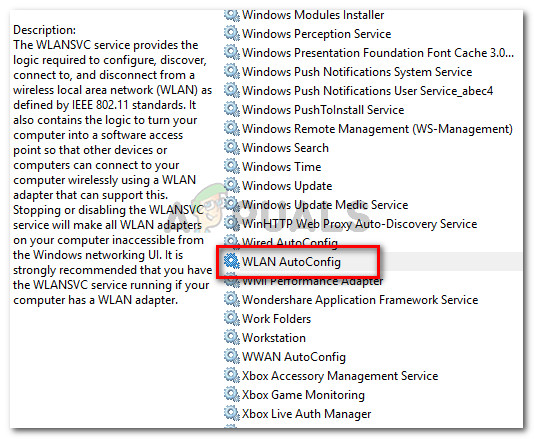
In the Services screen, double-click on WLAN AutoConfig - Inside the Properties screen, go to the General tab and set the Startup type to Automatic using the drop-down menu. Then, press Apply to save the changes.
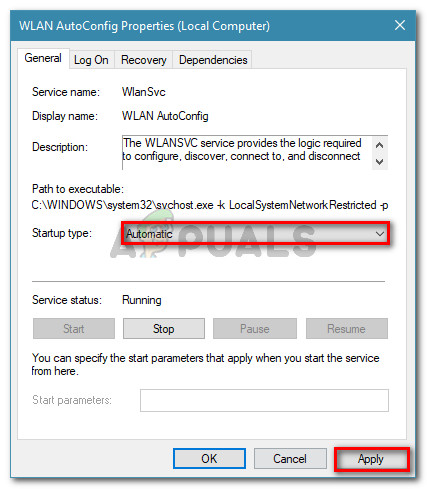
Set the Startup Type to Automatic, then press Apply to save the Changes - Reboot your machine. At the next startup, Windows should automatically start the WLAN AutoConfig service and resolve the issue.
If you’re still prevented from accessing the internet through your Wi-Fi, move down to the next method below.
Method 5: Using a system restore point
If you’ve come this far without a result, you can probably get the issue resolved if you happen to have a saved system restore point dated before you started experiencing the problem.
Some users in a similar situation reported that a system restore did it for them after a bad Windows update or a bad uninstallation of a VPN software.
An older System Restore point will revert your machine to a state where your Wi-Fi adapter was functioning properly. Here’s a quick guide on how to do this:
- Press Windows key + R to open up a Run dialog box. Then, type “rstrui” and press Enter to open the System Restore wizard.

Run dialog: rstrui - Wait until the utility is started, then select Choose a different restore point and click Next at the first prompt.
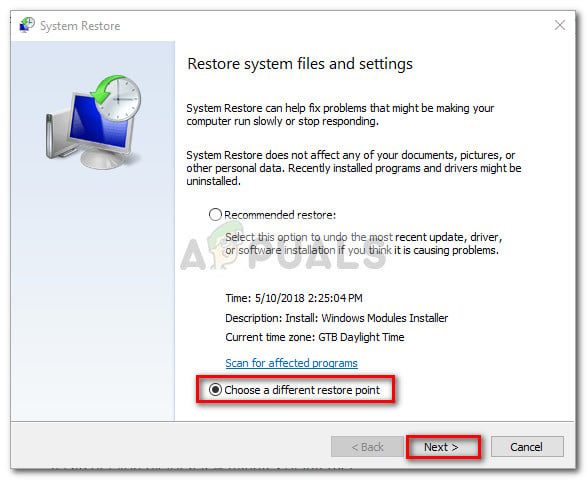
Select the Choose a different restore point toogle and hit Next - In the next screen, check the box associated with Show more restore points to get a full list of your restore points. Then, select a restore point that is dated before you started experiencing this issue and hit the Next button again.
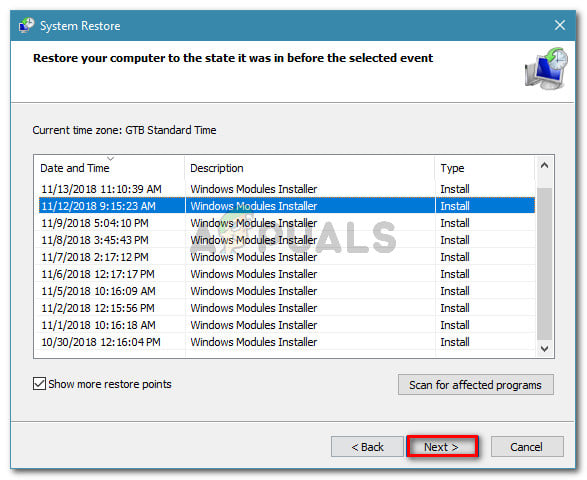
Select an older System Restore point and click Next - Upon clicking Finish, your computer will restart and the older machine state will be restored.
At the next startup, you should notice that your Wireless connection is working and you’re no longer encountering the “Windows couldn’t automatically bind the IP protocol stack to the network adapter” error.




